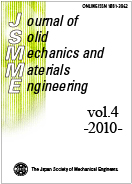Volume 4, Issue 7
Special Issue of APCMM2009 II
Displaying 1-24 of 24 articles from this issue
- |<
- <
- 1
- >
- >|
Papers
-
2010 Volume 4 Issue 7 Pages 864-874
Published: 2010
Released on J-STAGE: July 30, 2010
Download PDF (887K) -
2010 Volume 4 Issue 7 Pages 875-890
Published: 2010
Released on J-STAGE: July 30, 2010
Download PDF (4253K)
Special Issue of APCMM2009 II
Papers(Special Issue)
Environmental Strength, Corrosion
-
2010 Volume 4 Issue 7 Pages 891-897
Published: 2010
Released on J-STAGE: July 30, 2010
Download PDF (2668K) -
2010 Volume 4 Issue 7 Pages 898-907
Published: 2010
Released on J-STAGE: July 30, 2010
Download PDF (705K) -
2010 Volume 4 Issue 7 Pages 908-917
Published: 2010
Released on J-STAGE: July 30, 2010
Download PDF (1424K) -
2010 Volume 4 Issue 7 Pages 918-930
Published: 2010
Released on J-STAGE: July 30, 2010
Download PDF (3763K) -
Stress Intensity Effect on Solid State Oxidation of Ni-Cr Alloy with Different Chromium Concentrates2010 Volume 4 Issue 7 Pages 931-937
Published: 2010
Released on J-STAGE: July 30, 2010
Download PDF (927K)
Biomaterial, Medical Material
-
2010 Volume 4 Issue 7 Pages 938-945
Published: 2010
Released on J-STAGE: July 30, 2010
Download PDF (678K) -
2010 Volume 4 Issue 7 Pages 946-952
Published: 2010
Released on J-STAGE: July 30, 2010
Download PDF (754K) -
2010 Volume 4 Issue 7 Pages 953-962
Published: 2010
Released on J-STAGE: July 30, 2010
Download PDF (1009K)
Adhesion, Joint, Boundary Face
-
2010 Volume 4 Issue 7 Pages 963-973
Published: 2010
Released on J-STAGE: July 30, 2010
Download PDF (1875K) -
2010 Volume 4 Issue 7 Pages 974-987
Published: 2010
Released on J-STAGE: July 30, 2010
Download PDF (777K) -
Axisymmetrical Stress and Strength Analysis of Epoxy-Steel Composite Cylinders under Torsional Loads2010 Volume 4 Issue 7 Pages 988-998
Published: 2010
Released on J-STAGE: July 30, 2010
Download PDF (1088K) -
2010 Volume 4 Issue 7 Pages 999-1010
Published: 2010
Released on J-STAGE: July 30, 2010
Download PDF (412K) -
2010 Volume 4 Issue 7 Pages 1011-1026
Published: 2010
Released on J-STAGE: July 30, 2010
Download PDF (649K) -
2010 Volume 4 Issue 7 Pages 1027-1039
Published: 2010
Released on J-STAGE: July 30, 2010
Download PDF (632K) -
2010 Volume 4 Issue 7 Pages 1040-1050
Published: 2010
Released on J-STAGE: July 30, 2010
Download PDF (339K) -
2010 Volume 4 Issue 7 Pages 1051-1060
Published: 2010
Released on J-STAGE: July 30, 2010
Download PDF (555K)
Micro Nano Mechanics
-
2010 Volume 4 Issue 7 Pages 1061-1070
Published: 2010
Released on J-STAGE: July 30, 2010
Download PDF (1987K) -
2010 Volume 4 Issue 7 Pages 1071-1082
Published: 2010
Released on J-STAGE: July 30, 2010
Download PDF (1772K) -
2010 Volume 4 Issue 7 Pages 1083-1093
Published: 2010
Released on J-STAGE: July 30, 2010
Download PDF (496K)
Material Application, Control
-
2010 Volume 4 Issue 7 Pages 1094-1102
Published: 2010
Released on J-STAGE: July 30, 2010
Download PDF (4498K) -
2010 Volume 4 Issue 7 Pages 1103-1110
Published: 2010
Released on J-STAGE: July 30, 2010
Download PDF (4751K) -
2010 Volume 4 Issue 7 Pages 1111-1115
Published: 2010
Released on J-STAGE: July 30, 2010
Download PDF (507K)
- |<
- <
- 1
- >
- >|
